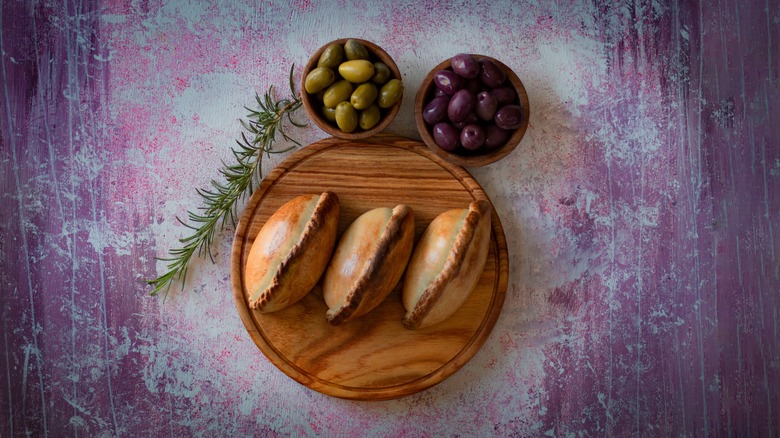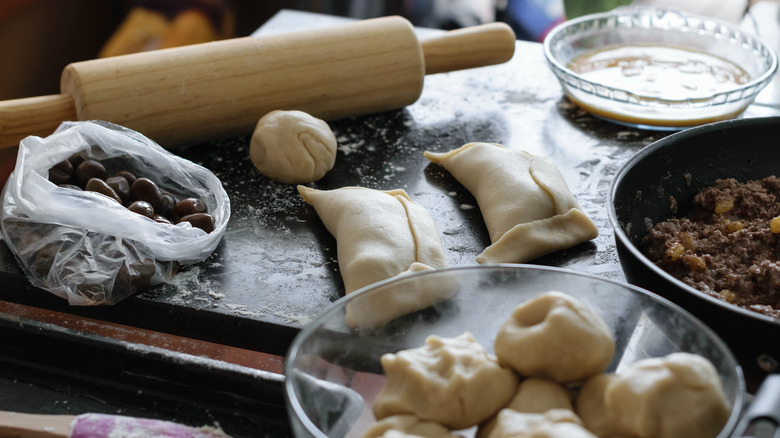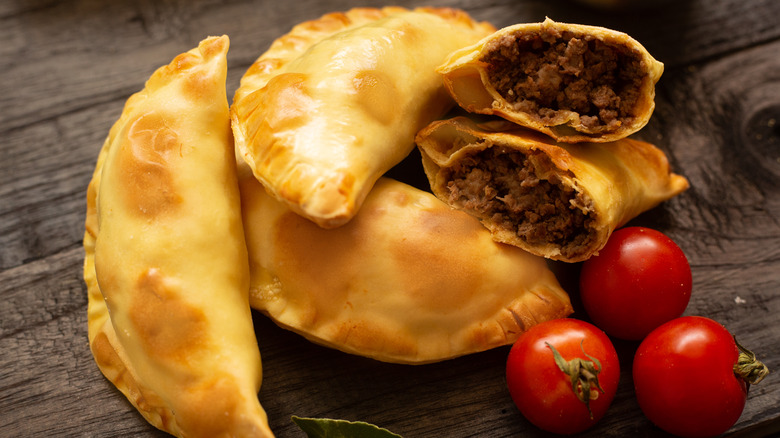Salteñas: The Savory Bolivian Hand Pies You Should Know About
Salteñas are oven-baked, broth-stuffed hand pies from Bolivia. For those who didn't get an A+ in geography, Bolivia is a landlocked country in central South America. Once the center of not one but two great indigenous empires — the Tiwanaku and Inca — the country is now widely diverse in demographics and cuisine (via Britannica).
According to Ruta Verde, we have Señorita Juana Manuela Gorriti to thank for the invention of the salteña. A political and literary writer, Gorriti was an Argentinian woman of many talents. It is reported that she eventually found her way to the Bolivian city of Potosí and began making salteñas. The name Gorriti gave her creation — the salteña — is supposedly due to her origins in Salta, Argentina (via Papis Pies). Today, the salteña is iconic in Bolivia and is often enjoyed as a morning meal. The adoption of salteñas into Bolivian culture is a perfect example of how this country is a conglomerate of different cultures, making it rich in traditional history.
What are salteñas?
The difference between a hand pie and a typical pie is the size. A hand pie is supposed to fit in the palm of your hand. Salteñas are baked to this gorgeous golden brown color with their buttery dough pinched together on one side, like an empanada or calzone. What sets it apart from other foods is its filling. Salteñas are usually stuffed with a mix of beef or chicken, potatoes, onions, peppers, spices, peas, olives, and — most interestingly — gelatin (via All Recipes).
You see, salteñas are like dumplings! They are incredibly juicy when you bite into them, and the broth spills out. To make this work, gelatin is added to the wet filling, and then the mix is left alone until it thickens. When the salteñas are put in the oven, the gelatin melts, and the broth turns back to a liquid, ensuring that the dough encasing it doesn't become soggy and fall to pieces (via Serious Eats).
How to cook salteñas
These Bolivian hand pies are tricky to make. They are often sold at salteñerías (restaurants built specifically to make and sell hand-made salteñas). The Bolivian cook and blogger Lizet tells us just how difficult it is to perfect these traditional snacks. She informs us that the oven is just as important as the recipe you're using when it comes to making a successful batch of salteñas. The oven has to be hot — like really hot — 470 degrees Fahrenheit hot (via Chipa by the Dozen).
You must make the filling ahead of time and let it fully cool with the gelatin inside before cooking, or you'll have a mess on your hands. Lizet advises that you can keep the filling you made in the fridge for up to three days to ensure it cools entirely, and you can replace the beef with chicken and add more potatoes if you are working on a budget.
You can also sneak a surprise into your salteñas. These South American treats can be time-consuming and complicated to make, so be patient!
Salteñas vs. empanadas
There is quite a bit of back and forth about whether a salteña is an empanada or in its own category. The Farmer's Almanac lists the empanada as a hand pie like the salteña, and, truth be told, they look pretty similar — both are golden pastries stuffed with meats and veggies. So, how are they different from each other?
An empanada can also be made with beef or chicken but does not use the broth or the gelatin the salteña is famous for. Empanada recipes are also highly diverse; they can be fried or baked, filled with various vegetables, and made savory or sweet from region to region (via Majuraps). This differs greatly from the salteña, with set ingredients and minimal variation. That being said, it seems that not all empanadas are salteñas, but salteñas are a regional style of the empanada.



